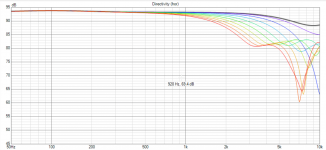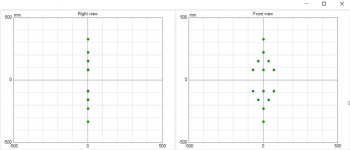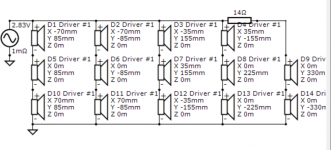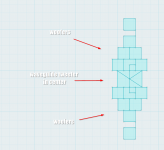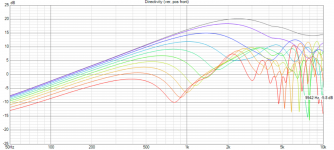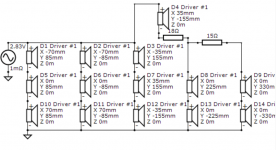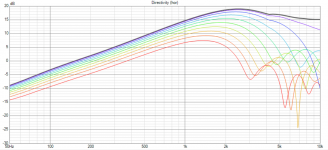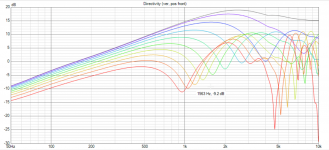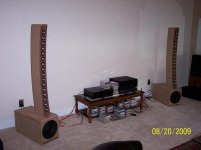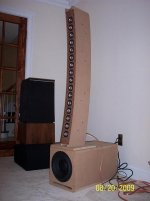I was definitely thinking the same thing.

This is a speaker that the designer of the Beolab 90 made for himself, before he made the 90. It's very reminiscent of the Snell and and Dunlavy designs, but with more diffraction control.

This is Augerpro's speaker. In the same vein.

This is the first prototype of the Beolab 90. Didn't work, because the woofers are too far apart: https://www.tonmeister.ca/wordpress/2015/10/06/beolab-90-behind-the-scenes/comment-page-2/

By packing them hexagonally, they made it work
I honestly wasn't trying to copy B&O 🙂
I was trying to implement the array that Dave Smith proposed twelve days ago, using passive filters, and found that I couldn't make it work without using a hideously complex crossover. Going with a hexagonal array solved that.
This is a speaker that the designer of the Beolab 90 made for himself, before he made the 90. It's very reminiscent of the Snell and and Dunlavy designs, but with more diffraction control.
This is Augerpro's speaker. In the same vein.
This is the first prototype of the Beolab 90. Didn't work, because the woofers are too far apart: https://www.tonmeister.ca/wordpress/2015/10/06/beolab-90-behind-the-scenes/comment-page-2/
By packing them hexagonally, they made it work
I honestly wasn't trying to copy B&O 🙂
I was trying to implement the array that Dave Smith proposed twelve days ago, using passive filters, and found that I couldn't make it work without using a hideously complex crossover. Going with a hexagonal array solved that.
Attachments
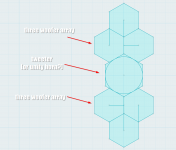

Here's a graph of the horizontal response of the hexagonal array. The animation shows what happens when you turn the center element on or off.
It basically illustrates that even though there are two woofers side by side, they're tight enough that they behave as one unit, up until 1khz.
In fact, there's an argument to be made that the xover point might work better at a higher frequency. Which would take a lot of strain off the center element. It might be possible to do this with a single dome tweeter in the center, instead of a Unity horn or 1.4" compression driver.
Linkwitz initially launched with such a design before working on downsizing. Microwave and antenna engineers are very familiar with designing symmetrical arrays, and naturally applied the same principles to an acoustic version in the wmtmw.
Shannon Dickson of Stereophile interviewed Linkwitz in 1996 when he launched the Beethoven Grand.
I enjoy your threads and data Patrick. I've wanted to build such an array for some time, but as you say; it's no small endeavor.
Jason
Shannon Dickson of Stereophile interviewed Linkwitz in 1996 when he launched the Beethoven Grand.
I enjoy your threads and data Patrick. I've wanted to build such an array for some time, but as you say; it's no small endeavor.
Jason
Attachments
I need another project like I need a hole in my head, but something that Keele mentioned in one of his CBT papers was that you could dramatically shorten the line by going dipole.
I didn't read the whole thing to get a good grasp on why that is, but it's an interesting option.
I didn't read the whole thing to get a good grasp on why that is, but it's an interesting option.
Dipoles maintain directivity into low frequency. It seems I remember him saying something about this with regard to their advantages.
This is the key point that is missing in Patrick's idea so far for it to work. Getting the central tweeter or cluster of tweeters to have the same or similar vertical directivity as the flanking mids. Without that the whole idea falls down. Trying to get an elliptical waveguide to produce enough vertical directivity to match anything other than two small tweeters without face plates and keeping it shallow enough to make a passive crossover practical is tricky, I have tried. Pinching the vertical of a rectangular guide like the Snell is easier and does allow the mids to sneak a bit closer into that pinch.The tweeter dispersion must be solved though. Now I would use an elliptical waveguide.
I have seen enough measurements of Sica coaxes now to think that they would also do a good job of solving the central driver problem at a reasonable cost, particularly if the aim is not to have very narrow vertical directivity. I've got all the parts to build either so maybe one day I will know the answer 🙂
This was my thought on a symmetric version with diffraction control on the central driversThis is a speaker that the designer of the Beolab 90 made for himself, before he made the 90. It's very reminiscent of the Snell and and Dunlavy designs, but with more diffraction control.
Inspired by @diypole I decided to try out using a dipole array.
These first sims are of a monopole, using something comparable to a Dayton ND64-16, the same driver that's in the Dayton "Epique" CBT speaker.
This is a fourteen element array. Every driver is receiving the same voltage; the "shading" is largely accomplished by using multiple units (horizontally) as we get closer to the center of the array.
For instance, the bottom edge of the array will radiate 80dB (because there's only one unit) but the row closest to the tweeter will radiate 89.5db because there's three drivers in a row : http://www.sengpielaudio.com/calculator-coherentsources.htm
The three drivers below the tweeter will combine constructively with the three tweeters above the tweeter, providing a combined output of 95.5dB just from those six midranges. (Because they're within a fraction of a wavelength.)
This is one of the reasons you need a really efficient tweeter in an array.
These first sims are of a monopole, using something comparable to a Dayton ND64-16, the same driver that's in the Dayton "Epique" CBT speaker.
This is a fourteen element array. Every driver is receiving the same voltage; the "shading" is largely accomplished by using multiple units (horizontally) as we get closer to the center of the array.
For instance, the bottom edge of the array will radiate 80dB (because there's only one unit) but the row closest to the tweeter will radiate 89.5db because there's three drivers in a row : http://www.sengpielaudio.com/calculator-coherentsources.htm
The three drivers below the tweeter will combine constructively with the three tweeters above the tweeter, providing a combined output of 95.5dB just from those six midranges. (Because they're within a fraction of a wavelength.)
This is one of the reasons you need a really efficient tweeter in an array.
Attachments
Here's the same array from post 28, but this time as a dipole.
You can see that the horizontal directivity is darn near perfect.
The vertical directivity is not as great. But the array 0.73 meters high; it's not difficult to listen on-axis. So the crummy vertical response, off axis, might be a "feature."
The attached sims are NOT normalized and you'd need to use DSP to flatten it out, no different than any dipole speaker.
You can see that the horizontal directivity is darn near perfect.
The vertical directivity is not as great. But the array 0.73 meters high; it's not difficult to listen on-axis. So the crummy vertical response, off axis, might be a "feature."
The attached sims are NOT normalized and you'd need to use DSP to flatten it out, no different than any dipole speaker.
Attachments
As noted in post 28, the geometry of the array shades the array by combining elements. https://www.diyaudio.com/community/threads/another-improved-array-sep-2022.390605/post-7132311
I added some resistors to the array, to make the shading nearly identical to the Keele CBT shading. (See crossover in attached post.)
This made the tiniest amount of improvement in the vertical directivity, about 1dB at 1khz. Very subtle.
What I am going to try next, is something very unorthodox, which is to take this array and focus it PHYSICALLY but flatten the wavefront in the passive crossover.
This is very unorthodox, but hear me out:
Something I really like about the Danley SH-50 is that it's really difficult to tell where the soundstage begins or ends. The depth of the sound stage is extremely nebulous.
I think one of the reasons for this is the very good polar response, but another part is that the midranges are nearly half a foot closer than the tweeter is but the passive crossover delays them in time. The Synergy horn crossover basically creates a speaker where the bass and the mids and the highs all radiate at different depths but what arrives at our ear is in-phase.
I think this is why the soundstage of the Danley SH-50 is so unique.
And I wonder if something similar could be achieved with an array...
I added some resistors to the array, to make the shading nearly identical to the Keele CBT shading. (See crossover in attached post.)
This made the tiniest amount of improvement in the vertical directivity, about 1dB at 1khz. Very subtle.
What I am going to try next, is something very unorthodox, which is to take this array and focus it PHYSICALLY but flatten the wavefront in the passive crossover.
This is very unorthodox, but hear me out:
Something I really like about the Danley SH-50 is that it's really difficult to tell where the soundstage begins or ends. The depth of the sound stage is extremely nebulous.
I think one of the reasons for this is the very good polar response, but another part is that the midranges are nearly half a foot closer than the tweeter is but the passive crossover delays them in time. The Synergy horn crossover basically creates a speaker where the bass and the mids and the highs all radiate at different depths but what arrives at our ear is in-phase.
I think this is why the soundstage of the Danley SH-50 is so unique.
And I wonder if something similar could be achieved with an array...
Attachments
In Sunday's post, I talked about the use of a converging array, something like the attached pics.
Here is my logic for a concave array:
1) if you use low pass filters which get increasingly larger towards the edges (an "expanding array") the delay introduced by the low pass filters can make the array behave as if it's flat when it's actually concave. By the same logic, you can make a flat array behave as if it's convex. JBL does that here: https://www.diyaudio.com/community/threads/passive-loudspeaker-delay.280664/
2) In the Danley SH-50, I find that the depth of the soundstage is vague, and I dig that
3) If I end up making it a dipole, the sound radiated to the back should be uncorrelated with the sound radiated to the front (because it's asymmetrical)

Something that I was surprised by, is that the "concave" array is actually well behaved at various distances IF you put a tweeter in the center of the array.
The animated gif above, shows the directivity of the concave array, when simulated at 6 meters, 3 meters, and 1.5 meters
Since the array is focused, you would assume that you'd need to keep your "head in a vise", but it looks like this isn't the case, if you use a single tweeter. (1khz is 34cm long.)
Overall, I think it's promising, particularly since I think varying the depths of the elements makes an audible improvement in the depth of soundstage.
Here is my logic for a concave array:
1) if you use low pass filters which get increasingly larger towards the edges (an "expanding array") the delay introduced by the low pass filters can make the array behave as if it's flat when it's actually concave. By the same logic, you can make a flat array behave as if it's convex. JBL does that here: https://www.diyaudio.com/community/threads/passive-loudspeaker-delay.280664/
2) In the Danley SH-50, I find that the depth of the soundstage is vague, and I dig that
3) If I end up making it a dipole, the sound radiated to the back should be uncorrelated with the sound radiated to the front (because it's asymmetrical)

Something that I was surprised by, is that the "concave" array is actually well behaved at various distances IF you put a tweeter in the center of the array.
The animated gif above, shows the directivity of the concave array, when simulated at 6 meters, 3 meters, and 1.5 meters
Since the array is focused, you would assume that you'd need to keep your "head in a vise", but it looks like this isn't the case, if you use a single tweeter. (1khz is 34cm long.)
Overall, I think it's promising, particularly since I think varying the depths of the elements makes an audible improvement in the depth of soundstage.
Attachments
Last edited:
I’m going to share experience outside the audiophile hifi realm in to what we recording engineers hear and listen for that helps us provide that stereo sweet spot you all love…..and that’s phase. When recording multi mic, panning and overlapping tones within a mix that need to live and breathe in their own space…..NOTHING is more distracting than crossover phase overlapp that remains focused within the stereo triangle……with a two way speaker crossed within 800-3khz, it’s the single most debilitating feature of a loudspeaker and the primary reason while most professional final mixes are done on 3 ways, typically dome loaded midrange drivers…….and clearly ATC dominates this sector for good reason. Take a look at the horizontal and vertical dispersion patterns of dome mids……any quality dome…..and i think you‘ll find what your looking for in a hybrid array/line source solution…..get that XO up to 3.5k or better and you’ll find that magic you’re looking for…….it’s a critical part of the mix/mastering systems that bring the music to you.
I wouldn't discount 24ch of DSP+AMPs as a solution. Extron XPA amps are cheap second hand im paying about £70 for 4*200W units and biamp nexia DSPs are also very cheap and capable. You could also use symetrix or QSC dsps. The main issue would be the rack required to house such a DSP amp and the wiring. You could use the multicores that are used on concert line arrays sometimes for wiring (can't remember the name but they are circular with loads of pins), often available cheap when equipment is been scrapped.
Hi Mayhem13,
Not to derail Patrick's very interesting thread, but i.m.o. your remarks about 3 ways and in particular dome mids, are somewhat moot: first of all the dispersion patterns of large 3" mid domes, e.g. the ATC, are not any better 30-90 degrees off axis than 3-4" cone mids, as many discussions and measurements here have shown, but furthermore this is all a matter of proper design of a uniform directivity speaker with matching directivity at x/o.
What do you mean by "crossover phase overlap that remains.... etc?
Not to derail Patrick's very interesting thread, but i.m.o. your remarks about 3 ways and in particular dome mids, are somewhat moot: first of all the dispersion patterns of large 3" mid domes, e.g. the ATC, are not any better 30-90 degrees off axis than 3-4" cone mids, as many discussions and measurements here have shown, but furthermore this is all a matter of proper design of a uniform directivity speaker with matching directivity at x/o.
What do you mean by "crossover phase overlap that remains.... etc?
what about the VDIR above 1.5 KHz?
I've been messing around with arrays, off and on, for almost 20 years now.
I never had results I was particularly happy with.
Dave Smith, who worked at JBL / McIntosh / Kef / Bose / Snell / etc posted a great thread on arrays recently here, and that thread made me realize that you can do the crossover in a way where the vertical height varies with frequency.
Basically, an "eXpanding Array" : https://www.google.com/search?q=david+smith+snell+expanding+array
That idea solved a lot of array problems for me; it basically allows you to design an array that behave like a conventional MTM from about 700HZ and up, but gets virtually taller as frequencies get lower.
This is really helpful I think. The "conventional" arrays, where all the elements are getting a full range signal, are difficult / impossible to integrate with a conventional or waveguide tweeter. Basically, if all of the woofers in an array are receiving a full range signal, you need to purchase a TON of tweeters.
Well simply put, not everything translates from measurements to our individual listening experience and the simple fact that regardless of measurement capability, there still exists tens of thousands of speaker systems over decades……and yet accolades will run the spectrum from apples to oranges and beyond……if it’s your assertion that what we hear translates to measurements across all parameters, yes…..my point for YOU would be moot.Hi Mayhem13,
Not to derail Patrick's very interesting thread, but i.m.o. your remarks about 3 ways and in particular dome mids, are somewhat moot: first of all the dispersion patterns of large 3" mid domes, e.g. the ATC, are not any better 30-90 degrees off axis than 3-4" cone mids, as many discussions and measurements here have shown, but furthermore this is all a matter of proper design of a uniform directivity speaker with matching directivity at x/o.
What do you mean by "crossover phase overlap that remains.... etc?
for the sake of discussion…..the ATC dome measures http://www.troelsgravesen.dk/ATC-SM75-150.htm
that’s a really impressive off axis response
uniform directivity?…….for whom or for what purpose exactly?…..do these desirable directivity characteristics translate to optimal in ALL listening spaces?……partial treated, untreated, fully?……high ceilings,….low…..no?……..hard surfaces, small spaces, large? Maybe 90…..maybe 60,….125…?…….which for which room?
matching directivity at XO?……….a Geddes mantra that gets tossed around here like accepted doctrine of the grail of speaker performance…….and yet even power response in a 3D space deserves less attention?
yes……there are audible degradations of tones within a stereo triangle across the response range encompassed by the crossover. You as the listener, have NO access to directly identify these phase peturbations as you have NO control over the L/R panning of tones within the context of listening……….but when mixing, the issues are readily audible and identified across different monitoring platforms……sometimes the suckout will line up so perfectly with the fundamental that to make it identifiable within 2-3 degrees change of a pan………unacceptable in a mix environment where an intended stereo image is intended to translate to thousands of critical listener. Your assertion suggests it no relevant to the design of systems unless it revealed in a response sweep or a single system channel or driver?……..I would only add if you listen in mono, you’d be right in your assertion.
What I believed to be the point of Patrick’s discussion here is line source or hybrids as opposed to line array…..eliminating early floor and ceiling reflections through vertical cancellations while still maintaining an ideal horizontal response for most listening environments that have reflection points within the horizontal range of directivity.…….and dome midrange drivers that isolate the critical listening range of 800hz to 4khz do just that……I would add do it better than anything in a typical listening environment, translating the music and its artistic intention from the mix and mastering desk. How that translates is anyone‘s guess……..it’s the reason why 10’s of thousands of systems exist to represent it in all its glory and the foundation of this forum………whe truth be told, anything outside of that mastering studio and the conditions are a crap shoot at best…………very little of what directivity plots and ’matched directivity’ at XO are going to significantly reduce those odds…….the BEST you could do in a 3D space is get right in there…..the sweet spot…..and enjoy what little (or a lot) of what the room contributes. Speaker systems will NEVER consistently represent that variable…….stop trying. Besides, Spatial Audio algorithms are doing just that for the masses and IMO will eliminate stereo shortly for all but the most die hard audiophile relics. For all intents and purposes, the stereo system is dead……….it just doesn’t know it yet.
Last edited:
Hi mayhem13, are you saying there is suckout with center panned material? or something else? just trying to get into whats the problem.yes……there are audible degradations of tones within a stereo triangle across the response range encompassed by the crossover. You as the listener, have NO access to directly identify these phase peturbations as you have NO control over the L/R panning of tones within the context of listening……….but when mixing, the issues are readily audible and identified across different monitoring platforms……sometimes the suckout will line up so perfectly with the fundamental that to make it identifiable within 2-3 degrees change of a pan………unacceptable in a mix environment where an intended stereo image is intended to translate to thousands of critical listener. Your assertion suggests it no relevant to the design of systems unless it revealed in a response sweep or a single system channel or driver?……..I would only add if you listen in mono, you’d be right in your assertion.
- Home
- Loudspeakers
- Multi-Way
- Another Improved Array - Sep 2022

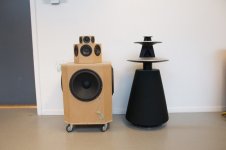

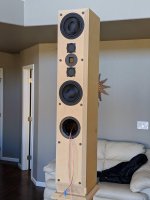
![b-grand-shannon[1].jpg](/community/data/attachments/1001/1001796-65887046724454b765c43e235099d40a.jpg?hash=ZYhwRnJEVL)
